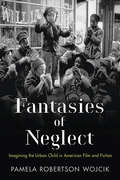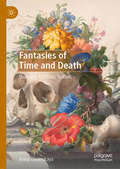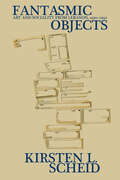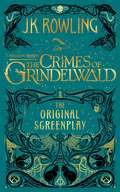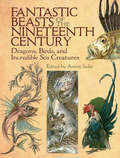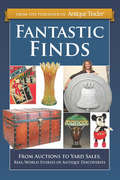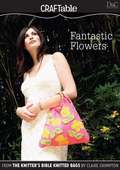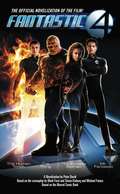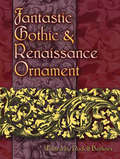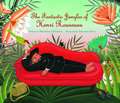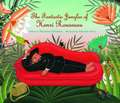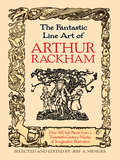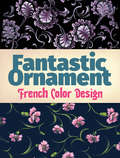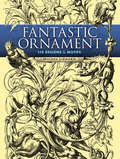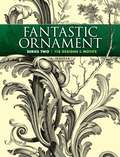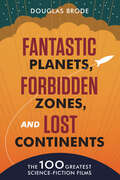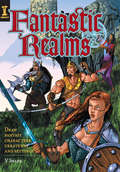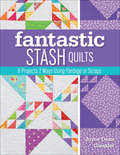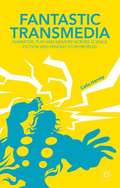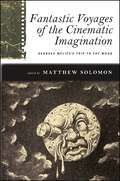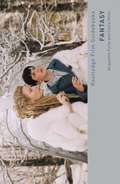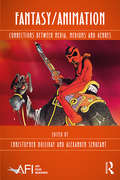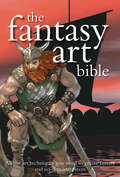- Table View
- List View
Fantasies of Neglect: Imagining the Urban Child in American Film and Fiction
by Pamela Robertson WojcikIn our current era of helicopter parenting and stranger danger, an unaccompanied child wandering through the city might commonly be viewed as a victim of abuse and neglect. However, from the early twentieth century to the present day, countless books and films have portrayed the solitary exploration of urban spaces as a source of empowerment and delight for children. Fantasies of Neglect explains how this trope of the self-sufficient, mobile urban child originated and considers why it persists, even as it goes against the grain of social reality. Drawing from a wide range of films, children's books, adult novels, and sociological texts, Pamela Robertson Wojcik investigates how cities have simultaneously been demonized as dangerous spaces unfit for children and romanticized as wondrous playgrounds that foster a kid's independence and imagination. Charting the development of free-range urban child characters from Little Orphan Annie to Harriet the Spy to Hugo Cabret, and from Shirley Temple to the Dead End Kids, she considers the ongoing dialogue between these fictional representations and shifting discourses on the freedom and neglect of children. While tracking the general concerns Americans have expressed regarding the abstract figure of the child, the book also examines the varied attitudes toward specific types of urban children--girls and boys, blacks and whites, rich kids and poor ones, loners and neighborhood gangs. Through this diverse selection of sources, Fantasies of Neglect presents a nuanced chronicle of how notions of American urbanism and American childhood have grown up together.
Fantasies of the Master Race: Literature, Cinema and the Colonization of American Indians
by Ward Churchill M. Annette JaimesIn this volume of incisive essays, Ward Churchill looks at representations of American Indians in literature and film, delineating a history of cultural propaganda that has served to support the continued colonization of Native America. During each phase of the genocide of American Indians, the media has played a critical role in creating easily digestible stereotypes of Indians for popular consumption. Literature about Indians was first written and published in order to provoke and sanctify warfare against them. Later, the focus changed to enlisting public support for "civilizing the savages," stripping them of their culture and assimilating them into the dominant society. Now, in the final stages of cultural genocide, it is the appropriation and stereotyping of Native culture that establishes control over knowledge and truth.
Fantasies of Time and Death: Dunsany, Eddison, Tolkien
by Anna VaninskayaThis book reveals the unique contribution made by the three founding fathers of British fantasy—Lord Dunsany, E. R. Eddison and J. R. R. Tolkien—to our culture’s perennial reassessment of the meanings of time, death and eternity. It traces the poetic, philosophical and theological roots of the striking preoccupation with mortality and temporality that defines the imagined worlds of early fantasy fiction, and gives both the form of such fiction and its ideas the attention they deserve. Dunsany, Eddison and Tolkien raise some of the oldest questions in existence: about the limits of nature, human and divine; cosmic creation and destruction; the immortality conferred by art and memory; and the paradoxes and uncertainties generated by the universal experience of transience, the fear of annihilation and the desire for transcendence. But they respond to those questions by means of thought experiments that have no precedent in modern literary history.
Fantasmic Objects: Art and Sociality from Lebanon, 1920-1950 (Public Cultures of the Middle East and North Africa)
by Kirsten L. ScheidIn Lebanon, the study of modern art—rather than power or hierarchy—has compelled citizens to confront how they define themselves as a postcolonial nation.In Fantasmic Objects, Kirsten L. Scheid offers a striking study of both modern art in Lebanon and modern Lebanon through art. By focusing on the careers of Moustapha Farrouk and Omar Onsi, forefathers of an iconic national repertoire, and their rebellious student Saloua Raouda Choucair, founder of an antirepresentational, participatory art, Scheid traces an emerging sense of what it means to be Lebanese through the evolution of new exhibition, pedagogical, and art-writing practices. She reveals that art and artists helped found the nation during French occupation, as the formal qualities and international exhibitions of nudes and landscapes in the 1930s crystallized notions of modern masculinity, patriotic femininity, non-sectarian religiosity, and citizenship. Examining the efforts of painters, sculptors, and activists in Lebanon who fiercely upheld aesthetic development and battled for new forms of political being, Fantasmic Objects offers an insightful approach to the history and formation of modern Lebanon.
Fantastic Beasts: The Crimes of Grindelwald - The Original Screenplay (Harry Potter)
by J. K. Rowling Mina Lima<p>J.K. Rowling's five-film Fantastic Beasts adventure series continues with the original screenplay for Fantastic Beasts: The Crimes of Grindelwald. <p>At the end of Fantastic Beasts and Where to Find Them, the powerful Dark wizard Gellert Grindelwald was captured in New York with the help of Newt Scamander. But, making good on his threat, Grindelwald escapes custody and sets about gathering followers, most unsuspecting of his true agenda: to raise pure-blood wizards up to rule over all non-magical beings. <p>In an effort to thwart Grindelwald's plans, Albus Dumbledore enlists Newt, his former Hogwarts student, who agrees to help once again, unaware of the dangers that lie ahead. Lines are drawn as love and loyalty are tested, even among the truest friends and family, in an increasingly divided wizarding world. <p>This second original screenplay from J.K. Rowling, illustrated with stunning line art from MinaLima, expands on earlier events that helped shape the wizarding world, with some surprising nods to the Harry Potter stories that will delight fans of both the books and films.</p>
Fantastic Beasts of the Nineteenth Century: Dragons, Birds, and Incredible Sea Creatures (Dover Fine Art, History of Art)
by Anton SederFanciful creatures slither, swim, and soar through this full-color adaptation of a rare 19th-century German portfolio. The colorful images include exotic birds and fishes, dramatic reptiles and amphibians, and scores of ferocious dragons. This new layout of a hard-to-find antique volume presents enlargements of the original illustrations that offer magnified details of stylized feathers, fins, scales, and other fantastic features. The tremendous variety of these images makes this volume a perfect resource for all manner of graphics and art reference. This meticulously reproduced collection of fanciful creatures represents the first republication of Anton Seder's bestiary since the original 1896 edition. The Munich-based painter is best known for Die Pflanze in Kunst und Gewerbe (The Plant in Art and Trade), which incorporated plants into decorative patterns, and Das Thier in Der Decorativen Kunst (Animals in Decorative Art), which similarly integrated animals and mythical dragons into ornamental motifs. Designers, artists, and crafters will appreciate Seder's imaginative works and their distinctive combination of outstanding designs with keen observations of nature.
Fantastic Finds
by Eric BradleyFantastic Finds is an engaging and entertaining collection of real-world stories of people who discover gold amongst the unwanted. You'll read how a $700 auction gamble turns into a $38,500 sapphire bracelet or how one intrepid seeker found two rare carnival glass bowls in one day. Of course, some of the tales are sentimental journeys, where found pieces prove to be touching and priceless. Big or small, prized or priceless, Fantastic Finds tells the tales that make us all yearn for the hunt. And the reward.
Fantastic Flowers
by Claire CromptonThis is a great bag for a hot summer's day. The vivid colours zing against each other, and the sewed-on leaves add a pleasing three-dimensional touch. The stylish flare shape is created by decreasing the sides and bamboo rings are attached for added impact. Knitted in ever-versatile cotton yarn, this bag is robust enough to take on the beach, and smart and sassy enough to take to summer garden parties.
Fantastic Four: Official novelization of the new film
by Peter DavidScientific genius Dr. Reed Richards' lifelong dream is close to being realized--a trip to space and to the center of a cosmic storm to unlock the secrets of the human genetic code. Financed by rival-turned-billionaire-industrialist Victor Von Doom, Reed's crew for the mission includes his best friend, astronaut Ben Grimm; Susan Storm, Von Doom's director of genetic research and Reed's ex-girlfriend; and Sue's hot-headed younger brother, pilot Johnny Storm. With benefactor Von Doom in tow, the four set off for the exploration of a lifetime. But something goes terribly wrong, as cosmic radiation irrevocably alters their DNA and their future. Back on Earth, the effects of the exposure are quickly revealed: Reed gains the ability to stretch and contort his body into any shape he can imagine. Sue is able to render herself invisible and to create and project powerful force fields. Johnny can now engulf his body in flames and take flight at will, and Ben, whose freakish transmutation is the most shocking, becomes an orange-colored, rock-like, superhumanly strong creature. Together, they turn tragedy into triumph and catastrophe into coalition, and must use their unique and formidable powers against Victor Von Doom--who has also not escaped the effects of the cosmic storm unscathed. Adventurers. Super Heroes. Celebrities. To the world, they are the Fantastic Four. To each other, they are a family.
Fantastic Gothic and Renaissance Ornament
by Rudolf BerlinerAn Archive of Spectacular ImagesSpotlighting Pivotal Designs in the History of Western ArtDancing beasts of myth and legend, thick foliage that appears to live and breathe, reclining figures engulfed by symbols of fate--this magnificent compendium of 15th- and 18th-century embellishments offers up a dizzying array of Gothic and Renaissance designs steeped in religion and fantasy. A marvel of art history, 127 exquisitely rendered black-and-white illustrations will thrill students and art aficionados, and serve as a rich source of inspiration for anyone working in the fine or applied arts.
The Fantastic Jungles of Henri Rousseau (Incredible Lives for Young Readers)
by Michelle MarkelHenri Rousseau wanted to be an artist. But he had no formal training. Instead, he taught himself to paint. He painted until the jungles and animals and distant lands in his head came alive on the space of his canvases. Henri Rousseau endured the harsh critics of his day and created the brilliant paintings that now hang in museums around the world. Michelle Markel's vivid text, complemented by the vibrant illustrations of Amanda Hall, artfully introduces young readers to the beloved painter and encourages all readers to persevere despite all odds.Watch the trailer:
The Fantastic Jungles Of Henri Rousseau
by Michelle Markel Amanda HallHenri Rousseau wanted to be an artist. But he had no formal training. Instead, he taught himself to paint. He painted until the jungles and animals and distant lands in his head came alive on the space of his canvases.<P> Henri Rousseau endured the harsh critics of his day and created the brilliant paintings that now hang in museums around the world. Michelle Markel's vivid text, complemented by the vibrant illustrations of Amanda Hall, artfully introduces young readers to the beloved painter and encourages all readers to persevere despite all odds.
The Fantastic Line Art of Arthur Rackham
by Arthur Rackham Jeff A. MengesArthur Rackham is widely regarded as one of the leading illustrators from the golden age of British book illustration, which encompassed the years from 1890 until the end of World War I. The acclaim for the artist's wealth of color illustrations has overshadowed the merit of his first-rate ink work, a genre richly deserving of individual attention. This original volume, the first available collection of Rackham's line art, features images from throughout his career, including illustrations for Alice in Wonderland, Peter Pan in Kensington Gardens, A Midsummer Night's Dream, and some rare periodical work. In addition, this compilation presents two seldom-seen magazine features on the artist: "Arthur Rackham: A Painter of Fantasies," a 1914 article from St. Nicholas Magazine; and "Arthur Rackham: The Wizard at Home," a 1905 article from The International Studio. The articles, not reprinted in over a century, contain pictures of Rackham's studio and residence as well as some direct commentary from the artist. Together with scores of strange and wonderful illustrations, they provide fresh insights into the work of the artist known as The Beloved Enchanter.
Fantastic Ornament: French Color Design (Dover Fine Art, History of Art)
by DoverDerived from a one-of-a-kind, hand-painted studio sourcebook of the early 1900s, the patterns in this stunning collection combine to form a treasury of bold, colorful designs. These images have never before appeared in print, and this compilation affords users a unique selection of remarkably brilliant motifs. Originating in Lyon, France's long-time silk capital, the patterns were created by anonymous designers for the embellishment of fabrics. Predominantly florals and foliates, these decorative figures pulse with brilliant colors — vivid scarlets, muted olives, pearly grays, salmon pinks, and other dazzling hues.Rendered in a full-page format, the designs are ideal for use in modern textiles, graphics, and a host of other art and craft projects. Their timeless beauty assures their ongoing value as a source of inspiration and royalty-free material for artists, designers, decorators, textile makers, and crafters.
Fantastic Ornament: 110 Designs and Motifs
by Michel LiénardSwirling with gargoyles, devils, dragons, griffins, and other images that haunt both dreams and nightmares, this otherworldly assortment features more than 100 decorations from a rare nineteenth-century volume. Decorations include:Cartouches in the style of Louis XIII; stone balustrades; arabesques; roof cornices; Renaissance-era drawing-room cabinets; Elizabethan chimney pieces; plus friezes for textiles and wallpaper, decorative scutcheons, mirror frames, and much more. These versatile royalty-free illustrations are equally suitable for immediate use, adaptation, and inspiration.
Fantastic Ornament, Series Two: 118 Designs and Motifs (Dover Pictorial Archive)
by A. HauserEngraved in the 19th century, these flamboyant ornamental designs are based on a wide variety of historical examples, dating back as far as the 1500s and including images by Watteau and Dürer. Created as embellishments for walls, arms and armor, and everyday objects, these designs remain eminently useful for graphic and decorative purposes.
Fantastic Planets, Forbidden Zones, and Lost Continents: The 100 Greatest Science-Fiction Films
by Douglas BrodeWhether you judge by box office receipts, industry awards, or critical accolades, science fiction films are the most popular movies now being produced and distributed around the world. Nor is this phenomenon new. Sci-fi filmmakers and audiences have been exploring fantastic planets, forbidden zones, and lost continents ever since George Méliès’ 1902 film A Trip to the Moon. In this highly entertaining and knowledgeable book, film historian and pop culture expert Douglas Brode picks the one hundred greatest sci-fi films of all time. Brode’s list ranges from today’s blockbusters to forgotten gems, with surprises for even the most informed fans and scholars. He presents the movies in chronological order, which effectively makes this book a concise history of the sci-fi film genre. A striking (and in many cases rare) photograph accompanies each entry, for which Brode provides a numerical rating, key credits and cast members, brief plot summary, background on the film’s creation, elements of the moviemaking process, analysis of the major theme(s), and trivia. He also includes fun outtakes, including his top ten lists of Fifties sci-fi movies, cult sci-fi, least necessary movie remakes, and “so bad they’re great” classics—as well as the ten worst sci-fi movies (“those highly ambitious films that promised much and delivered nil”). So climb aboard spaceship Brode and journey to strange new worlds from Metropolis (1927) to Guardians of the Galaxy (2014).
Fantastic Planets, Forbidden Zones, and Lost Continents: The 100 Greatest Science-Fiction Films
by Douglas BrodeWhether you judge by box office receipts, industry awards, or critical accolades, science fiction films are the most popular movies now being produced and distributed around the world. Nor is this phenomenon new. Sci-fi filmmakers and audiences have been exploring fantastic planets, forbidden zones, and lost continents ever since George Méliès’ 1902 film A Trip to the Moon. In this highly entertaining and knowledgeable book, film historian and pop culture expert Douglas Brode picks the one hundred greatest sci-fi films of all time. Brode’s list ranges from today’s blockbusters to forgotten gems, with surprises for even the most informed fans and scholars. He presents the movies in chronological order, which effectively makes this book a concise history of the sci-fi film genre. A striking (and in many cases rare) photograph accompanies each entry, for which Brode provides a numerical rating, key credits and cast members, brief plot summary, background on the film’s creation, elements of the moviemaking process, analysis of the major theme(s), and trivia. He also includes fun outtakes, including his top ten lists of Fifties sci-fi movies, cult sci-fi, least necessary movie remakes, and “so bad they’re great” classics—as well as the ten worst sci-fi movies (“those highly ambitious films that promised much and delivered nil”). So climb aboard spaceship Brode and journey to strange new worlds from Metropolis (1927) to Guardians of the Galaxy (2014).
Fantastic Realms!: Draw Fantasy Characters, Creatures and Settings
by V. Shane ColcloughCreate Your Own Fantastic Realms!An arduous journey leads you to a hilltop. Before you stretches a land of castles filled with noble knights, elven warriors and fearsome goblins and gargoyles. At your feet lies a book...Within its pages you will discover the secrets to sketching, drawing and coloring wondrous worlds - realms filled with creatures friendly and foul, beautiful princesses and stealthy magic-users, ancient ruins and dragons' lairs.Begin your journey by following the steps within, which will guide you from simple sketches to fully colored works of art. Take heart, brave traveler, for you'll be aided in your quest by:Texture and coloring keys that show you exactly how to create dozens of different effectsA brainstorming game that, with a roll of the dice, allows you to mix and match character, creature and scene characteristicsBut beware, friend: Along the way, you will be powerless to resist the temptation to explore the strange and twisted detours of your own utterly original imaginings. Wield your pencil bravely - so begins your adventure...30+ step-by-step demonstrations make it easy to create your own fantastic worlds!The Characters: Human or elf, fighter or princess ... learn to outfit your characters with specialized clothing, weaponry and magical items, and tell their tales with dynamic gesture and motion.The Creatures: Evoke dragons, demons, griffins and other edgy beasts of your own twisted imaginings, with special attention to key details that make them look regal or demented.The Settings: Construct convincing environments that set the tone and atmosphere of your story, be it a mysterious tower, ancient ruins or a peaceful village.
Fantastic Stash Quilts: 8 Projects 2 Ways Using Yardage or Scraps
by Joyce Dean GieszlerPut your quilter’s stash to work with 8 easy patterns that can be made in scrap or yardage variations for a total of 16 fabulous quilts!These 8 quilt patterns, each shown in 2 distinct looks, will have you reimagining your stash! Piece beautiful blocks from your scraps or uniformly plan your approach from fabric yardage. Plus get easy sewing and pressing tips to remake quilts in your favorite fabrics. With line drawings of each quilt to color in, the possibilities are endless! Even beginning quilters will be able to jump right in and sew these colorful stash quilts.
Fantastic Transmedia: Narrative, Play and Memory Across Science Fiction and Fantasy Storyworlds
by Colin B. HarveyContemporary culture is packed with fantasy and science fiction storyworlds extending across multiple media platforms. This book explores the myriad ways in which imaginary worlds use media like films, novels, videogames, comic books, toys and increasingly user-generated content to captivate and energise contemporary audiences.
Fantastic Voyages of the Cinematic Imagination: Georges Méliès's Trip to the Moon (SUNY series, Horizons of Cinema)
by Matthew Solomon"Best moving pictures I ever saw." Thus did one Vaudeville theater manager describe Georges Méliès's A Trip to the Moon [Le Voyage dans la lune], after it was screened for enthusiastic audiences in October 1902. Cinema's first true blockbuster, A Trip to the Moon still inspires such superlatives and continues to be widely viewed on DVD, on the Internet, and in countless film courses. In Fantastic Voyages of the Cinematic Imagination, leading film scholars examine Méliès's landmark film in detail, demonstrating its many crucial connecions to literature, popular culture, and visual culture of the time, as well as its long "afterlife" in more recent films, television, and music videos. Together, these essays make clear that Méliès was not only a major filmmaker but also a key figure in the emergence of modern spectacle and the birth of the modern cinematic imagination, and by bringing interdisciplinary methodologies of early cinema studies to bear on A Trip to the Moon, the contributors also open up much larger questions about aesthetics, media, and modernity.In his introduction, Matthew Solomon traces the convoluted provenance of the film's multiple versions and its key place in the historiography of cinema, and an appendix contains a useful dossier of primary-source documents that contextualize the film's production, along with translations of two major articles written by Méliès himself.
Fantasy (Routledge Film Guidebooks)
by Claire Hines Jacqueline FurbyFantasy addresses a previously neglected area within film studies. The book looks at the key aesthetics, themes, debates and issues at work within this popular genre and examines films and franchises that illustrate these concerns. Contemporary case studies include: Alice in Wonderland (2010) Avatar (2009) The Dark Knight (2008) Edward Scissorhands (1990) Lord of the Rings (2001-2003) Pirates of the Caribbean (2003-2007) Prince of Persia: The Sands of Time (2010) Shrek (2001) Twelve Monkeys (1995) The authors also consider fantasy film and its relationship to myth, legend and fairy tale, examining its important role in contemporary culture. The book provides an historical overview of the genre, its influences and evolution, placing fantasy film within the socio-cultural contexts of production and consumption and with reference to relevant theory and critical debates. This is the perfect introduction to the world of fantasy film and investigates the links between fantasy film and gender, fantasy film and race, fantasy film and psychoanalysis, fantasy film and technology, fantasy film storytelling and spectacle, fantasy film and realism, fantasy film and adaptation, and fantasy film and time.
Fantasy/Animation: Connections Between Media, Mediums and Genres (AFI Film Readers)
by Christopher Holliday Alexander SergeantThis book examines the relationship that exists between fantasy cinema and the medium of animation. Animation has played a key role in defining our collective expectations and experiences of fantasy cinema, just as fantasy storytelling has often served as inspiration for our most popular animated film and television. Bringing together contributions from world-renowned film and media scholars, Fantasy/Animation considers the various historical, theoretical, and cultural ramifications of the animated fantasy film. This collection provides a range of chapters on subjects including Disney, Pixar, and Studio Ghibli, filmmakers such as Ralph Bakshi and James Cameron, and on film and television franchises such as Dreamworks’ How To Train Your Dragon (2010–) and HBO’s Game of Thrones (2011–).
The Fantasy Art Bible (Artist's Bibles Ser.)
by Quarto Publishing GroupAn inspirational and practical guide to fantasy and science fiction art techniques.
